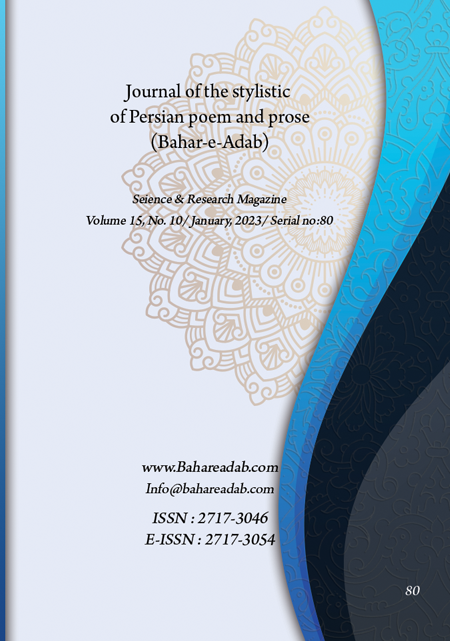- Count View : 262
- آدرس کوتاه شده مقاله: https://bahareadab.com/article_id/1378
- کد doi مقاله: Doi: 10.22034/bahareadab.2022 .15 .6466
Journal of the stylistic of Persian poem and prose
volume Number 15،
number In Volume 10،
،
issue Number 80
Stylistics of the mashi and mashianeh book
Simin Gholami (Author in Charge), Masoumeh Shabestari
Abstract
BACKGROUND AND OBJECTIVES: Mohammad Ali is one of the prominent and capable writers with a style in contemporary Persian literature. therefore; It is important to study his works from a stylistic point of view. This article examines the stylistic features of the story of "Mashi and Mashianeh" at three levels of thought, language and literature with examples of the story. The main purpose of this article is to review and explain the characteristics of the story of "Mashi and Mashianeh" in three levels.
METHODOLOGY: Ongoing research; It has been done in a descriptive-analytical way.
FINDINGS: Mohammad Ali has established a new method in the field of novel writing with the publication of Mashi and Mashianeh. He was able to create a unique style by combining colloquial language and novel prose and relying on religious, mythological and historical sources. Mohammad Ali"s poetry has added to the beauty of the work in parts of the story while showing the author"s ability. The most important literary feature of this author is the use of novel virtues, especially similes, which mainly have sensory and research aspects.
CONCLUSION: At the intellectual level, the author, while giving importance to the position of women in the story, narrates the story in the language of women. Adherence to ethics and behavior, dream, dream, love, explaining the concept of Iranian myths and myths are the most important intellectual features of this work. At the linguistic level, his use of Arabic words and his disobedience in the syntactic structure are other features of the story. At the literary level, the author has tried to use the words, content and structures of ancient literature in a pleasant way. He has used rhetorical industries such as puns, rhymes, etc. in spiritual rhetorical industries of contradictions and observations such as many and many similes.
Keyword
Style
, Mohammad Mohammad Ali
, myth
, Female
- Abdollahian, H. (1999). Contemporary prose work.7nd ed. Tehran: Paya, p.19.
- Afifi, R. (1995). Myths of Iranian culture in Pahlavi writings. Tehran: Toos, p.522.
- Aghda’ei, T. (2002). The role of imagination. 1nd ed . Zanjan: Nikan Ketab, p.8.
- Bahar, M. (1997). Research in Iranian mythology. Tehran: Toos, p.176.
- Biniaz, F. (2014). An Introduction to Fiction and Narrative Studies), 5nd ed. Tehran: Afraz, p. 207.
- Ebadian, M. (1993). An Introduction to Stylistics in Literature. 2nd ed, Tehran: Avaye No, p.44.
- Forum, E. (2001). Forgotten language. translated by Ebrahim Amanat. 7nd ed. Tehran: Firoozeh, p.31.
- Ismailpour, A. (2003). The scope of myth. 2nd ed. Tehran: Hermes, p.4.
- Jideh, A. (2010). New manifestations in contemporary Arabic poetry. Beirut: Nofel Institute, p.105.
- Kharachenko, M. (1984). Creative individuality of the author and the evolution of literature. translated by Nazi Azima. Tehran: Agah, p.97.
- Mirsadeghi, J. (2006). Story elements. 5nd ed. Tehran: Sokhan, p.705.
- Mohammad Ali, M. (2015). mashi and mashianeh. 2nd ed. Tehran: Ghazal, Pp.1-226.
- Nikobakht, N. (2005). Postmodernism and its reflection in the gypsy novel on fire. Journal of Mashhad Faculty of Literature and Humanities, No. 148, Pp. 164-179.
- Pornuroz, F. (2005). From the bottom of the valley to the first day of love Conversation with Mohammad Mohammad Ali. Vancouver Canada: Print Depot Publishing, p.12.
- Rimmon, Sh. (2008). Narrative - Contemporary Poetry., translated by Abolfazl Horri. Tehran: Niloufar, p.130.
- Safavi, k. (2013). Seven Talks About Translation. Tehran: Surah Mehr, p.75.
- Shamisa, S. (2008). Stylistics of prose. 12nd ed. Tehran: Mitra, p.274.
- Shamisa, S. (2009). Generalities of stylistics. 3nd ed. Tehran: Mitra, p.153, 216.
- Stanzel, F. (1984). A theory of narrative. charlotte goedsche. cambridge: cambridgeup, p.160.
- Younesi, E. (2005). The art of storytelling. Tehran: Amirkabir, p.33.

